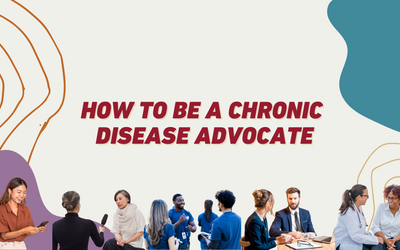
When people think of advocacy, they often picture rallies or people speaking at the Capitol —but advocacy takes many forms. Whether you're posting on social media, talking to your doctor or writing your legislator, you're using your voice to make a difference. In celebration of Chronic Disease Month, we’re breaking down the five common types of advocacy and sharing examples of them in action.
Digital Advocacy
Digital or online advocacy is one of the easiest and most accessible ways to get involved. Think TikToks, Instagram posts, online petitions, and email campaigns. For example, for Chronic Disease Month, we created a letter you can send to your state and federal lawmakers asking them to put patients first by prioritizing progress, access and affordability. It’s fast (takes less than three minutes to send), it’s far-reaching, and it gives everyone a platform.
News Media Advocacy
Ever read an op-ed that made you stop and think? That’s news media advocacy in action. It involves using newspapers, TV, or radio to reach the public and decision-makers. A great example is Chrisa Hickey's 2024 letter to her local paper about how step therapy hurt her son's disease management. These stories humanize issues and bring them into the public eye.
Policy Advocacy
This type gets right to the source — working to change laws or policies. At the CDC, our advocates often meet with lawmakers, testify at hearings, or participate in public comment periods. For example, CDC Ambassador Anna Williams started using her voice to represent patients after receiving training from the Alliance for Headache Disorders Advocacy. It's about turning lived experience into legislative action. Learn more about policy advocacy.
Medical Advocacy
Medical advocacy focuses on helping people navigate healthcare systems. It could be as personal as a patient or caregiver speaking up to ensure they or their loved one gets the right diagnosis or treatment. Some of our partner organizations, like the National Kidney Foundation, train peer mentors to help people living with kidney disease understand their care options.
Community Engagement
Advocacy doesn’t always happen behind a podium. Community engagement involves grassroots efforts to bring people together through town halls, support groups, or local coalitions. The Headache Alliance created a large-scale display of flags on Capitol Hill to raise awareness for migraine and headache during Migraine and Headache Awareness Month in June. That’s advocacy, too.
Each of these advocacy types plays a unique role in creating change. You don’t have to be a professional lobbyist or have a huge platform. The simple act of speaking up and sharing your story matters.
Get Started Today!
Your voice is powerful, and there are many ways to use it. Here are five ideas to help you start your advocacy journey with the CDC:
- Check out our advocacy tools – Use these tools to learn more about and get started with advocacy.
- Contact your elected leaders – Elected officials want to hear from the people they serve. Use our easy-to-fill out forms to tell your story to your representatives in less than five minutes.
- Share your story – We’ll share it with elected officials, the media and others to show what it’s like to live with a chronic disease.
- Subscribe to our newsletter – Twice a month you’ll receive updates, stories and requests to elevate the patient voice in your community.
- Become an ambassador – As a CDC Ambassador, you will be actively involved in creating local, state and national change to protect chronic disease patient rights.